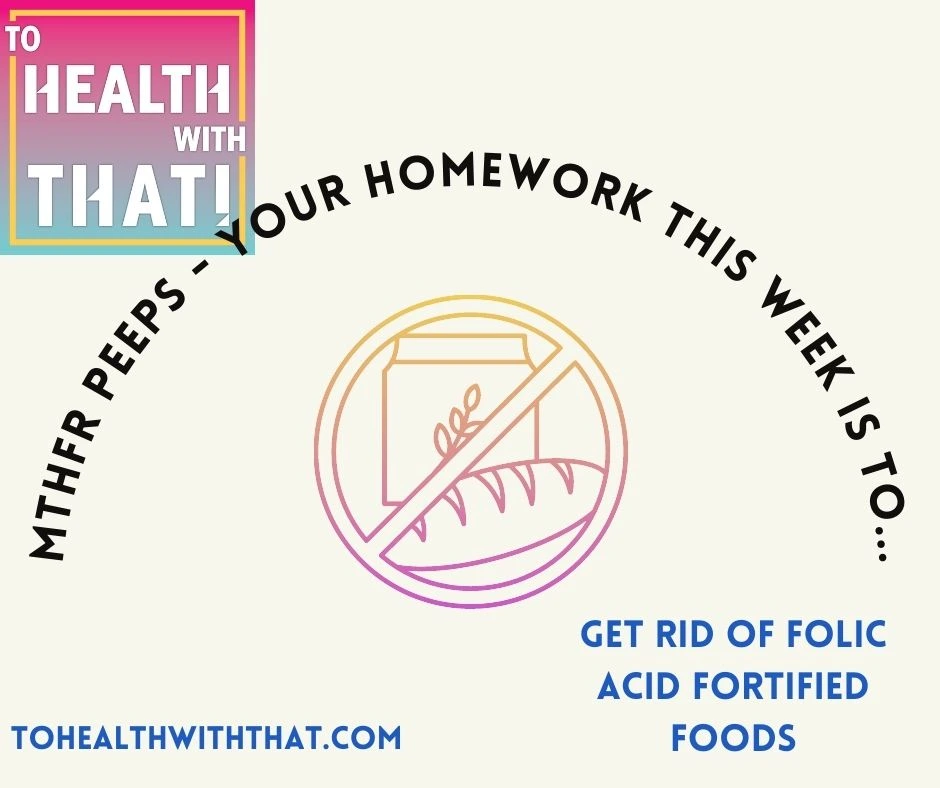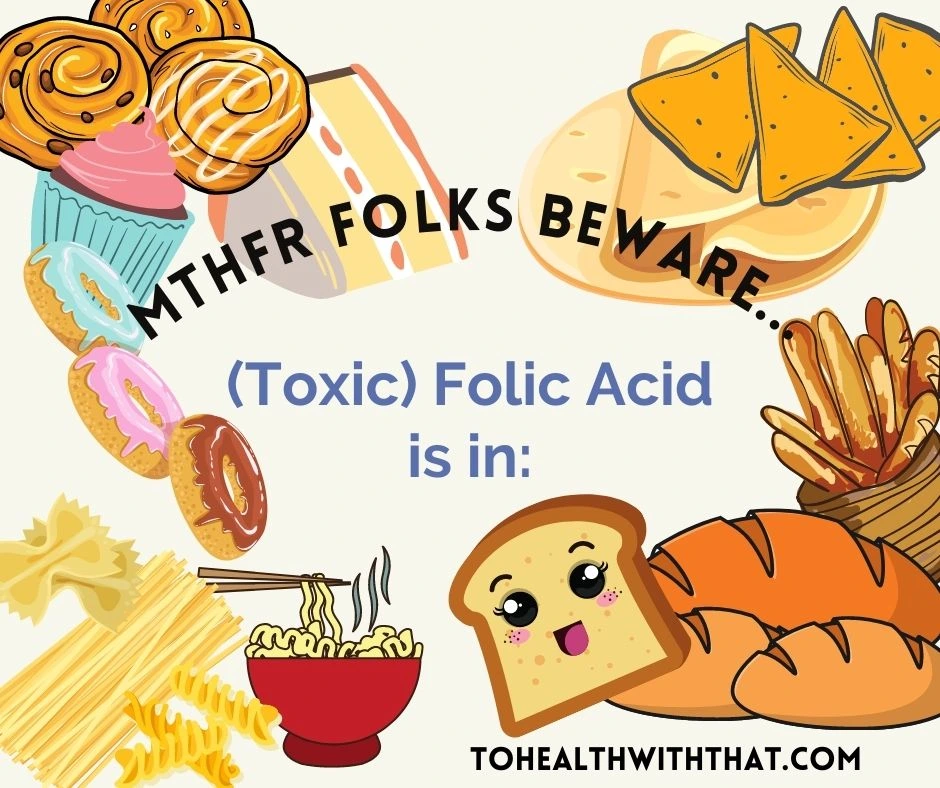I know it’s poor planning on my part to start this season off with the hardest part of this whole process, but sadly this is the only good way to start. If you skip this step, you can create mountains of problems for future you. Keeping folic acid in sounds good to so many people, but folic acid actually blocks the other, more useful forms of folate from being utilized. I talked a lot about the technical details in this post. This basically makes all the work you’re thinking about doing to add in natural food sources of folate or to take expensive 5-LMTHF supplements, worthless. All the money you spend on those things becomes wasted as well.

Folic acid also hangs out in your bloodstream as unmetabolized folic acid, or UMFA which contributes to many health problems for MTHFR folks and non-MTHFR folks alike, including increased risk of many forms of cancer.
This is step one, and ignoring it is far, far easier than actually doing it, but you’ll regret it in the long run. Honestly, it won’t even serve you in the short term because eliminating folic acid from your diet can show you a lot about how you react to folates in general. It’s a huge part of this journey and skipping it isn’t a great option. I know it’s hard but stay with me.
Folate is vital to our functioning as humans and especially to the healthy making of babies, which is a pretty big deal. Folate deficiency during pregnancy leads to major preventable complications like cleft palate, spina bifida, anencephaly, heart defects, low birth weight, and stillbirth. Because it’s so important, many governments around the world have adopted programs to fortify commonly eaten foods with the synthetic form of folate, which is our nemesis, folic acid.
This public health measure has had a tremendous impact on the rate of these birth defects, which is wonderful. It just doesn’t take into account people with the MTHFR mutation, or a culture that generally over-eats and over-supplements the way we are prone to in North America.
As a caveat to public health in general, even for MTHFR folks some folate in the worst form, folic acid, is better than none at all. This measure makes sense for society. The problems start to happen when either there is too much folic acid, which is now very common, or when there are too many compromised copies of the MTHFR gene.
So this week, if you want to follow along with this MTHFR adventure, you are ditching all of the folate fortified foods and starting with a folic-acid-free diet. Nothing else should change. Just get the folic acid out of there. This includes supplements as well so if your multivitamin, B-complex, energy-booster, or meal-replacement has folic acid in it or says “folate” on the label, then it’s out. If you’re dropping supplements, try not to add anything back in right now unless it’s absolutely necessary – we’ll look for particular things in the weeks to come and there’s no sense rushing out to buy something you might be changing shortly.
In the US, there are two foods that are fortified with folic acid. Those are wheat and corn, which are pretty much the backbone of every American meal out there. This means your bread, pasta, tortillas, corn chips, baked goods, even the doughnuts have to go. Here’s a bit more about what to eat and what not to eat for MTHFR folks.

This is the moment when people’s eyes bulge menacingly and a tic starts in one of their eyelids. Typically, spittle flies out of their mouths when they say, “But, but, then what do I eat?”
Have no fear. There is actual food left, but you might have to look around a bit. First off, you can still have wheat products as long as they are certified organic. In order to earn organic certification, they have to be unadulterated. In terms of bread, finding an organic option, or a sprouted whole-grain option is probably the best one.
For pasta, there are not so many organic options, but lots of gluten-free options that are not fortified – look for any pasta that claims to be gluten-free, or rice pasta that is made of rice and therefore not fortified.
For the baked goods, you’re going to be in a bit of trouble. There are some gluten-free options but they’re pretty limited if you’re used to the smorgasbord of wheat-based options. Sorry about that. Even baking at home has to be different because wheat flour is mostly enriched. Some whole wheat flour is safe, but some still has added folate so read your labels.
I can see that tic under your eye intensifying, so let me just reassure you that there is also every meat, veggie, fruit, and nut option under the sun. It is really just your major sources of carbs that are taking a hit. I know, that reassurance is entirely too thin for anybody’s liking.

This is the hardest part of the whole thing, so stick with me – it’s all so much simpler from here. Just keep using the symptom tracker that you started last week to see if you notice anything from the folate elimination. People are often surprised to find that something as mundane as bread can be causing them so much mental and physical pain.
It’s a bit last-minute, but I’m just offering a course starting September 15th called Methylfolate masterclass to answer the #1 question I get, which is, “How do I know when I’m taking the right dose of 5-LMTHF?” If you’re interested you can find out more at tohealthwiththat.com but register now because the cart closes at 11:59 pm Monday the 13th.
Thanks so much for listening today and if any of you are brave enough to come back next week, we’ll lighten it all up with talk about some amazing high-folate foods that you can add in to your diet to give your body good sources of natural folate. It will be great! To everyone who didn’t throw their device out the window when I started talking about not eating wheat, thanks for hanging in there!
MTHFR is a common genetic mutation that can contribute to anxiety, depression, fatigue, chronic pain, infertility, and more serious conditions like breast implant illness, heart attack, stroke, chronic fatigue syndrome, and some types of cancer. If you know or suspect you have an MTHFR variant, schedule a free 15-minute meet-and-greet appointment with MTHFR expert Dr. Amy today.
Book Your Appointment
